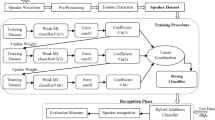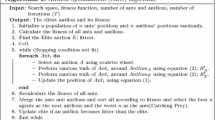Abstract
Feature selection is an important task which can affect the performance of pattern classification and recognition system. This study uses two nature-inspired algorithms, namely genetic algorithms and particle swarm optimization, for this problem. The algorithms adopt classifier performance and the number of the selected features as heuristic information, and select the optimal feature subset in terms of feature set size and classification performance. From experimental results, the major contribution of this work are: the reduction of vector feature size without loosing performance which is crucial for real time application and low-resources devices as well as the time needed to find the optimal subset features compared to exhaustive search or other conventional methods (less than 50 iterations instead of billions of iterations to test all possible configurations).








Similar content being viewed by others
References
Aha, D. W., & Bankert, R. L. (1996). A comparative evaluation of sequential feature selection algorithms. In D. Fisher & J.-H. Lenx (Eds.), Artificial intelligence and statistics. New York: Springer-Verlag.
Aiben, A. E., & Smith, J. E. (2007). Introduction to evolutionary computing. Natural Computing Series. Berlin: Springer.
Cantu-Paz, E. (2004). Feature subset selection, class separability, and genetic algorithms. In Genetic and evolutionary computation conference (pp. 959–970). Berlin: Springer.
Cantu-Paz, E., Newsam, S., & Kamath, C. (2004). Feature selection in scientific application. In Proceedings of the ACM SIGKDD international conference on knowledge discovery and data mining (pp. 788–793). New York: ACM.
Day, P., & Nandi, A. K. (2007). Robust text-independent speaker verification using genetic programming. IEEE Transactions on Audio, Speech, and Language Processing, 15(1), 285–295.
Deb, K. (1998). Genetic algorithm in search and optimization: The technique and applications. In Proceedings of international workshop on soft computing and intelligent systems (pp. 58–87).
Duda, R. O., & Hart, P. E. (1973). Pattern classification and scene analysis. New York: Wiley lnterscience.
Geetha, K., Thanushkodi, K., & Kumar, A. K. (2008). New particle swarm optimization for feature selection and classification of microcalcifications in mammograms. In International conference on signal processing, communications and networking (ICSCN ’08) (Vol. 4, pp. 458–463).
Harrag, A., & Mohamadi, T. (2010). QSDAS: New quranic speech database for arabic speaker recognition. AJSE Journal, 35(2C), 7–19.
Harrag, A., & Mohamadi, T. (2011). Best fusing of acoustic and prosodic features: Application to speaker recognition. In IEEE International conference ICMCS’11, pp. 1–5.
Harrag, A., Saigaa, D., Boukharouba, K., Drif, M., & Bouchelaghem, A. (2011). GA-based feature subset selection: Application to Arabic speaker recognition system. In 11th International conference on Hybrid Intelligent Systems (pp. 383–387).
Harrag, F., El-Qawasmeh, E., & Al-Salman, A. S. (2011). Extracting named entities from prophetic narration texts (Hadith). ICSECS, 2, 289–297.
Jain, A., & Zongker, D. (1997). Feature selection: Evaluation, application, and small sample performance. IEEE Transactions on Pattern Analysis and Machine Intelligence, 19, 153–158.
Jensen, R. (2005). Combining rough and fuzzy sets for feature selection. Ph.D. thesis, University of Edinburgh.
Kennedy, J., & Eberhart, R. (1995). Particle swarm optimization. In Proceedings of IEEE international conference on neural networks (Vol. 4, pp. 1942–1948).
Kira, K., & Rendell, L. (1992). A practical approach to feature selection. In Proceedings of the ninth international conference on machine learning (pp. 249–256). Aberdeen: Morgan Kaufmann.
Kwon, S., & Narayanan. S. (2002). Speaker change detection using a new weighted distance measure. In Proceedings of international conference on spoken language processing (ICSLP’02) (pp. 2537–2540). Denver.
Lopez, F. G., Torres, M. G., Batista, B. M., Perez, J. A. M., & Moreno-Vega, J. M. (2006). Solving feature subset selection problem by a parallel scatter search. European Journal of Operational Research, 169, 477–489.
Rajavarman, V. N., & Rajagopalan, S. P. (2007). Feature selection in data-mining for genetics using genetic algorithm. Journal of Computer Science, 3(9), 723–726.
Reynolds, D. A., & Rose, R. C. (1995). Robust text-independent speaker identification using Gaussian mixture speaker models. IEEE Transactions on Speech and Audio Processing, 3(1), 72–83.
Rokach, L. (2008). Genetic algorithm-based feature set partitioning for classification problems. Journal Pattern Recognition, 41(5), 1676–1700.
Siedlecki, W., & Sklansky, J. (2008). On automatic feature selection. International Journal of Pattern Recognition and Artificial Intelligence, 2(2), 197–220.
Wiley, J., Xiang, S. B., & Berger, T. (2003). Efficient text-independent speaker verification with structural Gaussian mixture models and neural network. IEEE Transactions on Speech and Audio Processing, 11(5), 447–456.
Zamalloa, M., Rodríguez L. J., Peñagarikano, M., Bordel, G., & Uribe J. P. (2008). Comparing genetic algorithms to principal component analysis and linear discriminant analysis in reducing feature dimensionality for speaker recognition. In GECCO’08 (pp. 1153–1154).
Zhang, D., Zhang, L., & Lu, H. (2009). Evolutionary discriminant feature extraction with application to face recognition. EURASIP Journal on Advances in Signal Processing, 2009, 1–12.
Author information
Authors and Affiliations
Corresponding author
Rights and permissions
About this article
Cite this article
Harrag, A. Nature-inspired feature subset selection application to arabic speaker recognition system. Int J Speech Technol 18, 245–255 (2015). https://doi.org/10.1007/s10772-014-9264-2
Received:
Accepted:
Published:
Issue Date:
DOI: https://doi.org/10.1007/s10772-014-9264-2




